Homemade Udon Noodle Soup with Chicken and Scallions (Tori Nanban Udon)
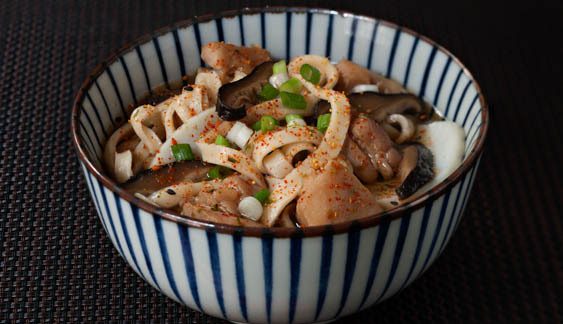
introduction
Udon are thick wheat noodles brought to Japan from China about a thousand years ago. Although udon has become a staple throughout Japan, it was Sanuki Province (known today as Kagawa Prefecture) that possessed the semi-arid climate and rich valley soil for growing exceptional winter wheat for making noodles. In time, Sanuki became the center of udon artisanship in Japan and the moniker for the most popular style of udon in modern times.
Before Western influence washed through the Orient, udon (pronounced ooh-dohng—equal emphasis on the syllables and an almost nonexistent G at the end) was originally made exclusively of local freshly milled flour and seawater. Off-white in hue, the dough could change dramatically with temperature and humidity.
In addition to winter wheat, Sanuki Province produced—and still produces—sea salt of rare quality. Some say this resource and the region’s unique climate drove the quest for perfect Sanuki udon. As udon culture spread throughout Japan, artisans learned to produce it by adjusting the salt and water content in the dough until its texture was ideal. In addition to having noteworthy flavor, great udon possessed “slurpability,” or throat feel (nodogoshi in Japanese). In fact, Japanese devotees slurp it straight down their throats without chewing. Liquid wheat!
Though rural Japanese villages resisted the introduction of cheap imported industrial flour until the Second World War, Western influence ultimately changed udon. Oral histories across rural Japan repeat the story of men departing for military service before 1942 and returning after the war to find that their traditional delicate off-white udon had been replaced with stark white noodles bearing the same name. “Lack of flavor” is a recurrent phrase in their stories.
In Japan, just as in the Western world, modern processes used to amend natural wheat flour strengthen it, oxidize it, bleach it, give it wider parameters of workability, and make it overall more consistent—at the expense of robust new crop mill flavors, distinctive minerality, and nutrition. Modern flour has become farther and farther removed from the notion of living local wheat, the influence of terroir, and unique natural characteristics of wheat variety. But there is good news: the Japanese government, through its cultural support enterprises, repatriated local wheat production beginning a decade ago, and traditional udon has a small and growing presence in former Sanuki and elsewhere in the country.
We knew nothing of this when Dawn began making udon with Anson Mills flour. An udon-o-phile since childhood, she was struck not only by the golden color and more yielding texture of the noodles made with our flour—characteristics that most modern diners would label as faults—but also by the big, sweet, fresh flavors of the wheat (to read a little more about this, click here). This was udon from ancient times.
The wildly flavorful noodles, plump enough to be called Rubenesque and exquisitely slurpable, are made from Anson Mills French Mediterranean White Bread Flour. This is a supremely satisfying dish, one you will be proud to serve and thrilled to eat.
Itadakimasu!
Cooking Remarks
Working the gluten in the dough demands your full weight and sense of purpose: we follow the traditional kneading method of stomping it until it’s muscular and resistant. It won’t be quick, but if you and your feet persevere, the dough will become powdery soft to the touch.
Japanese udon masters knead the dough by foot but roll and cut it by hand. However, because this dough is a touch on the surly side, we use a pasta machine to roll out beautiful sheets, and then hand-cut noodles of even thickness. We think of it as a culinary cultural exchange rather than a tricky shortcut.
Japanese tradition gives cooked noodles a quick chill-down to set the starch and reheats them to serve, but as we mention in the introduction, these udon noodles are fragile. They didn’t like the old one-two, so we cook and serve them posthaste.
equipment mise en place
For the dashi, you will need a medium saucepan, a fine-mesh strainer, coffee filters or cheesecloth, and a large heatproof bowl.
For the udon, you will need a large mixing bowl, a wooden spoon, a plastic dough scraper, a liquid measuring cup or small bowl, a heavy-duty gallon-size zipper-lock bag, a bath towel if your kitchen flooring is very hard or textured, a rolling pin, a pasta machine, a rimmed baking sheet, a fine-mesh strainer, a ruler, a sharp chef’s knife or cleaver, and a clean kitchen towel. To cook the noodles, you will need a large stockpot and a large mesh skimmer or strainer.
For marinating and cooking the chicken, you will need a medium mixing bowl, a 2-quart sauteuse or medium skillet with a lid, and a wooden spoon.
For serving, you will need four noodle bowls, a ladle, and a slotted spoon. Chopsticks and renge (Japanese-style soupspoon) are the traditional eating utensils.
-
for the dashi and soup broth:
-
8cups spring or filtered water
-
1ounce kombu
-
2cups (0.625 ounce) lightly packed bonito flakes (katsuobushi)
-
4½tablespoons Japanese soy sauce
-
¼cup mirin
-
-
for the udon:
-
15ounces (3 cups) Anson Mills French Mediterranean White Bread Flour
-
7ounces spring or filtered water, warm
-
4teaspoons fine sea salt
-
Cornstarch for rolling out the dough and cutting the noodles
-
-
for the chicken and shiitake mushrooms:
-
3tablespoons Japanese soy sauce
-
2tablespoons sake
-
2tablespoons mirin
-
1½teaspoons sugar
-
About 14ounces boneless, skinless chicken thighs, trimmed of excess fat and cut into ¾-inch pieces (12 ounces trimmed weight)
-
0.75ounces (about 4) dried shiitake mushrooms, soaked in hot water for 15 minutes until softened
-
-
embellishments:
-
8thin slices kamaboko (steamed fish cake), optional
-
3scallions
-
Shichimi togarashi (“seven-spice” powder)
-
-
Make the dashi and soup broth: Pour the water into a medium saucepan and add the kombu, breaking the piece(s) to fit into the pan. Cover the pot and set aside for at least 30 minutes to allow the kombu to release its full flavor.
-
Set the pan, partially covered, over medium heat and allow the liquid to heat slowly. When it is just shy of reaching a simmer, add the bonito flakes and turn off the heat. Cover and let steep for 3 minutes. Meanwhile, line a fine-mesh strainer with dampened coffee filters or a double thickness of cheesecloth and set it over a large heatproof bowl.
-
Remove the kombu from the pan; it can be used to make a secondary (and more mildly flavored) dashi. Pour the dashi through the lined strainer. You should have between 6 and 7 cups of strained dashi (some is lost to evaporation). Rinse out the saucepan and return 6 cups of the dashi to it. Add the soy sauce and mirin, and then cover and set aside.
-
Make the udon dough: Put the flour into a large mixing bowl. With a wooden spoon, create a well in the center. Measure the water into a liquid measuring cup or small bowl and add the salt. Stir until the salt dissolves, and then pour the water all at once into the well. Using the wooden spoon, begin stirring the water, gradually drawing in the flour (fig. 4.1). When the mixture forms a shaggy mess (not “mass”) and the spoon is no longer effective at mixing, use a plastic dough scraper to push off the bits clinging to the spoon (fig. 4.2). With your hands, mix and knead the dough directly in the bowl. Work in the floury bits, using a firm squeezing action (fig. 4.3) before moving into classic bread kneading motions. The process will take a good 10 minutes and some determination, but gradually the dough will become smooth and taut and the bowl will be clean. Do not add additional water. Shape it into a round (fig. 4.4), and place the round in a heavy-duty gallon-size zipper-lock bag. Press out as much air as possible and seal the bag. Let the dough rest at room temperature for 30 minutes to 1 hour.
-
Marinate the chicken: Combine the soy sauce, mirin, sake, and sugar in a medium bowl and stir to dissolve the sugar. Add the chicken pieces and toss to coat. Cover and refrigerate while you make the noodles. Meanwhile, squeeze the soaked shiitake mushrooms to remove excess water. Trim off and discard the stems and cut the caps into ⅛-inch slices. Cover and set them aside.
-
Knead the udon dough: If your kitchen flooring is very hard or textured, fold a bath towel in half and lay it on the floor. Set the bag with the dough on the floor (on the towel, if using) and step on it using slow, deliberate motions, working from the center of the dough out to the edges (fig. 6.1). When the dough is flattened to the dimensions of the bag, pick up the bag, open it, fold the dough into quarters, and return it to the bag. Seal the bag, leaving an inch or so open, and repeat the foot-kneading and folding process until the dough is extremely strong, smooth, and resilient, about 8 turns in 10 minutes’ time. The dough will feel tacky at first, then very stubborn, but with repeated kneading, it will become satiny smooth and supple. Fold the dough into quarters and let it rest inside of the bag for 15 minutes. Resume kneading and folding for another 5 to 6 minutes, let the dough rest for 15 minutes, give it a final 5- to 6-minute round of kneading, and then let it rest once again, this time for about 30 minutes. Remove the dough from the bag. Using a rolling pin, roll it into a 12 by 8-inch rectangle (fig.6.2). Fold the top third of the dough down (fig. 6.3) and the bottom third of the dough up to create long, flat loaf. Cut the dough crosswise into three equal pieces (fig. 6.4). Return the pieces to the plastic bag to rest for 15 to 30 minutes.
-
Roll and cut the noodles: Set up a pasta machine and sift cornstarch over a rimmed baking sheet. Remove a piece of dough from the bag and, using your hands, gently stretch and flatten it into a rectangle about 7 inches long and 5 inches wide. Run it twice through the widest setting on the pasta machine. If the strip of dough emerges from the pasta machine thinner at one end, feed the thin end through the pasta machine first on the next pass. Sprinkle cornstarch on the both sides of the dough strip and pass it twice through the second widest setting. If the ends of the dough are thinner than the rest of the band, stretch to square them off or trim the ends. The dough should be a band just about 1/16 inch thick (fig. 7.1). Generously sprinkle the dough with cornstarch and then fold the band crosswise into thirds. Rotate the folded rectangle so that the two opposing open sides are facing left and right, if they aren’t already. Using a sharp chef’s knife or cleaver and decisive motions, cut the dough perpendicular to the folds into noodles 3/16 inch wide—no wider (fig. 7.2). If the end noodles are very uneven, toss them out. With a light touch, separate and shake out the noodles into strands; try not to stretch them. Lay them out on the cornstarch-dusted baking sheet and dust with a bit more cornstarch (fig. 7.3). Cover with a clean kitchen towel and repeat with the remaining 2 pieces. The noodles, covered with the towel, can be held at room temperature for up to 2 hours.
-
Cook the chicken: Transfer the chicken pieces and the marinade to a 2-quart sauteuse or medium skillet. Stir in the shiitake mushrooms. Place the pan over medium heat. When the liquid reaches a gentle simmer, stir with a wooden spoon, cover, and cook, stirring occasionally and adjusting the heat to maintain a light simmer, until the chicken is just cooked through, about 10 minutes. Set the pan, covered, off the heat.
-
Cook and serve the udon: Heat the soup broth, covered, over medium heat until barely simmering. Bring 5 to 6 quarts of water to a boil in a large stockpot over high heat. Lift about one-quarter of the noodles with your fingers and gently shake off the excess cornstarch. Lower them into the boiling water (fig. 9.1). Repeat with another portion so that you’re cooking about one-half of the noodles at once, and then stir gently to separate the strands. Cook until the noodles are tender but retain a pleasant chew, about 3 minutes. Using a large mesh skimmer or strainer, scoop out the noodles and transfer them to warmed noodle bowls. Repeat with the remaining noodles, dividing them evenly among the bowls.
-
Thinly slice the scallions. Ladle the hot broth into the bowls, dividing it evenly. Using a slotted spoon, divide the chicken mixture among the bowls and arrange 2 slices of kamaboko on top of each. Sprinkle scallions onto each serving and serve right away, passing the shichimi togarashi at the table.
-
-
4.1
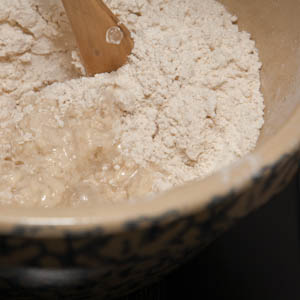
-
4.2
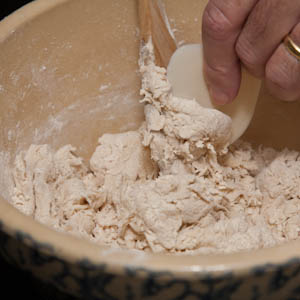
-
4.3
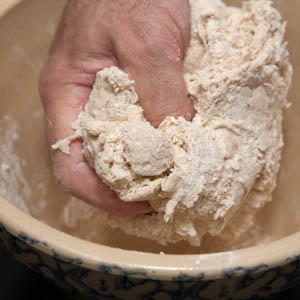
-
4.4
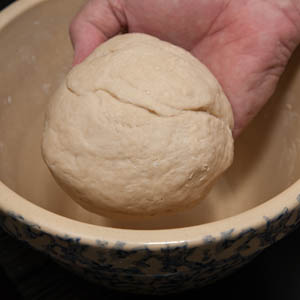
-
-
-
6.1
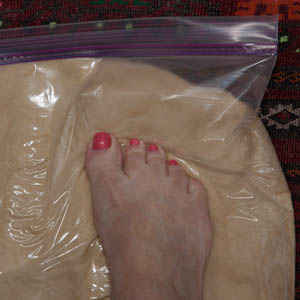
-
6.2
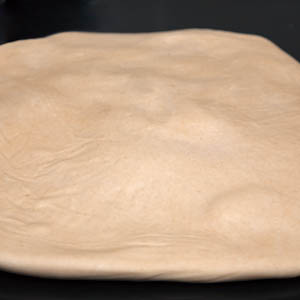
-
6.3
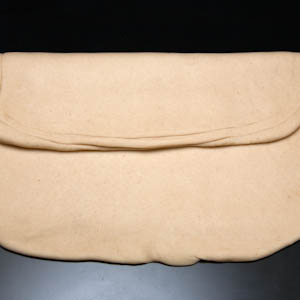
-
6.4
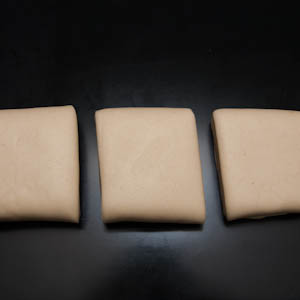
-
-
-
7.1
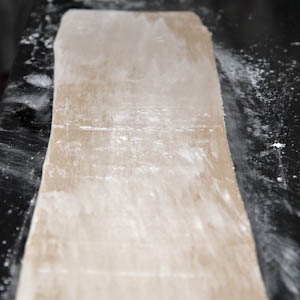
-
7.2
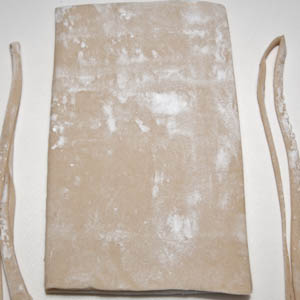
-
7.3
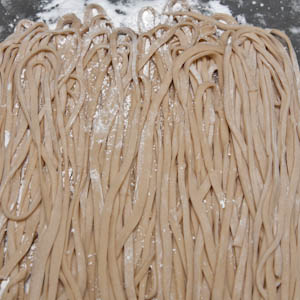
-
-
-
9.1
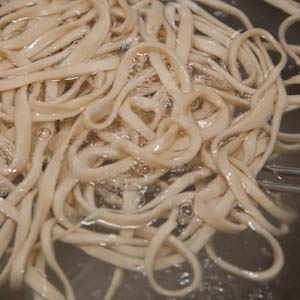
-